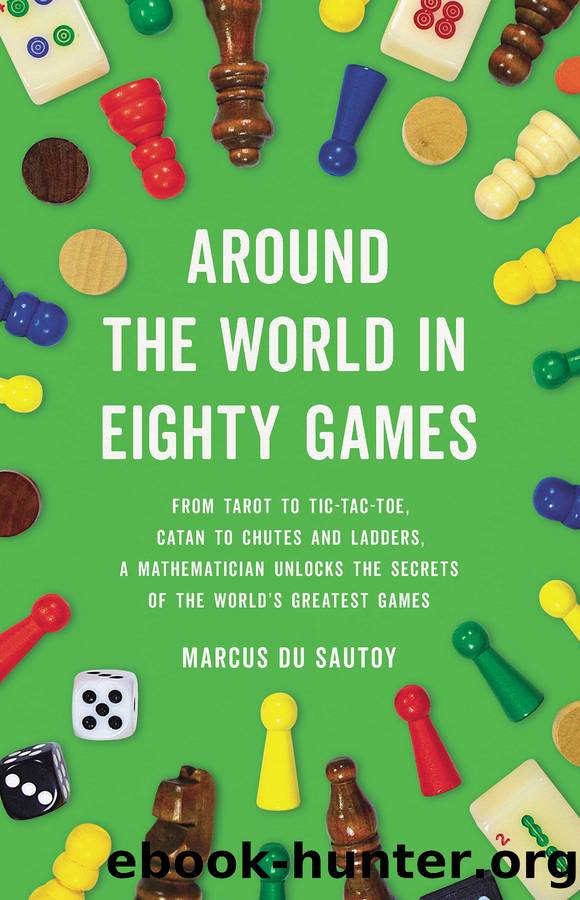Around the World in Eighty Games by Marcus du Sautoy

Author:Marcus du Sautoy [Du, Marcus Sautoy]
Language: eng
Format: epub
Publisher: Basic Books
Published: 2023-11-07T00:00:00+00:00
38: Mu Torere
MU TORERE IS PLAYED ON AN eight-pointed star. The board might be drawn in the sand or carved into wood or bark or marked out with a piece of charcoal. Each player has four counters that are placed on the points of the star. Traditionally counters might be pebbles, bits of vegetables, or, after contact with European travelers, broken bits of china. All that really mattered was that it be clear which counters belonged to which player. This game was simple to make and easy to set up, like many African games we will explore later in our journey.
The players are allowed to move their counters either into the center of the star, called the putahi, or to an adjacent empty star point, called a kawai. Putahi has the association of streams meeting at a junction, while kawai refers to a tree branch or even the tentacles of an octopus. The game is won if you block your opponent from moving. They are then declared piro, meaning âoutâ or âdefeated,â although it can also mean âputridâ or âfoul smelling.â Interestingly, in modern games we often say a player stinks if he or she plays badly. In order to ensure that the first player canât easily force a win, an additional rule demands that the first two moves by each player be made by stones marked with an asterisk.
The mathematical analysis of how to play this game was first investigated by Marcia Ascher, a pioneer in ethnomathematics who worked at Ithaca College in New York State.
The first question is whether the game actually can be won. Though the gameâs complexity can make it difficult to know where to start, one clever move to answer this question is to simplify the setup. I often use this strategy to try to crack a puzzle. If we start with just a two-pointed star, rather than an eight-pointed star, and each player has one counter, then the game never stops because there is no way to block your opponent. Either the center or the adjacent star is free to move to. The same happens with a four-pointed star.
Once we start playing with a six-pointed star, things begin to get interesting. Now it is possible for either player to block their opponent. There are thirty different configurations that the board might assume described in the following table. The first entry tells you whose go it is, the second entry tells you whose stone is in the center or whether the center is unoccupied, and the last six entries indicate the arrangement of stones around the star. Configuration (1) or (25) is the starting position for the game according to whether A or B plays first.
Download
This site does not store any files on its server. We only index and link to content provided by other sites. Please contact the content providers to delete copyright contents if any and email us, we'll remove relevant links or contents immediately.
| Applied | Geometry & Topology |
| History | Infinity |
| Mathematical Analysis | Matrices |
| Number Systems | Popular & Elementary |
| Pure Mathematics | Reference |
| Research | Study & Teaching |
| Transformations | Trigonometry |
Weapons of Math Destruction by Cathy O'Neil(5049)
Factfulness: Ten Reasons We're Wrong About the World – and Why Things Are Better Than You Think by Hans Rosling(4033)
Factfulness_Ten Reasons We're Wrong About the World_and Why Things Are Better Than You Think by Hans Rosling(2760)
Descartes' Error by Antonio Damasio(2745)
A Mind For Numbers: How to Excel at Math and Science (Even If You Flunked Algebra) by Barbara Oakley(2696)
TCP IP by Todd Lammle(2647)
Applied Predictive Modeling by Max Kuhn & Kjell Johnson(2489)
Fooled by Randomness: The Hidden Role of Chance in Life and in the Markets by Nassim Nicholas Taleb(2423)
The Book of Numbers by Peter Bentley(2413)
The Tyranny of Metrics by Jerry Z. Muller(2408)
The Great Unknown by Marcus du Sautoy(2195)
Once Upon an Algorithm by Martin Erwig(2153)
Easy Algebra Step-by-Step by Sandra Luna McCune(2127)
Practical Guide To Principal Component Methods in R (Multivariate Analysis Book 2) by Alboukadel Kassambara(2100)
Lady Luck by Kristen Ashley(2082)
Police Exams Prep 2018-2019 by Kaplan Test Prep(2041)
Linear Time-Invariant Systems, Behaviors and Modules by Ulrich Oberst & Martin Scheicher & Ingrid Scheicher(1987)
All Things Reconsidered by Bill Thompson III(1965)
Secrets of Creation, Volume 1: The Mystery of the Prime Numbers by Watkins Matthew(1875)
